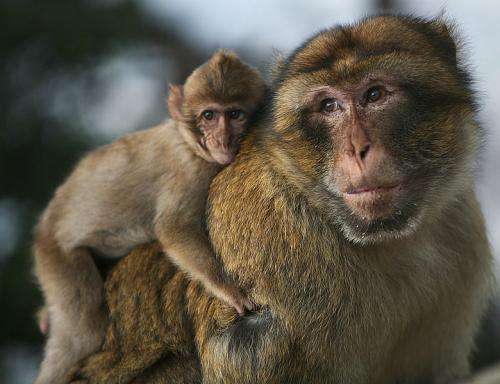December 12, 2018 report
Researchers find positive visual contagion in Barbary macaques

A pair of researchers at the University of Roehampton has found that captive Barbary macaques are capable of engaging in positive visual contagion—a behavior normally only seen in humans. In their paper published in Proceedings of the Royal Society B, Juliette Berthier and Stuart Semple describe their experiments with Barbary macaques living in a park in the U.K. and what they learned from it.
Prior research has shown that humans sometimes engage in what is known as positive visual contagion. This is when an individual encounters another individual behaving in a positive way and responds by behaving in a positive way. An example would be a person entering their office in the morning and encountering someone who seems to be in a cheerful mood—just seeing that person being cheerful can have a positive impact on the person seeing it. When the second person then behaves in a positive way and is seen by a third person who is then impacted, the reason for labeling it as a contagion becomes clear. Until now, it has not been known if positive visual contagion occurs with other animals, though there has been some anecdotal evidence suggesting it does—usually for a short time. In this new effort, the researchers report seeing such behavior in Barbary macaques, and that some episodes lasted up to a half-hour.
The researchers studied 20 of the female macaques living in a partially free-range park. Because grooming has been shown to be a positive experience, they used it as a measure when conducting their positive visual contagion experiments. They also used more clear cues such as hugging and touching. The researchers also watched for other behaviors such as scratching or yawning—signs of unhappiness or stress. If a macaque stopped performing such an activity upon witnessing something positive, it was counted as an example of positive visual contagion.
The researchers report that they witnessed several examples of positive visual contagion between the macaques. When one of the individuals was feeling nervous, for example, they became visibly less agitated when watching others grooming or being groomed. They also made themselves more readily available for such activities. They were also seen to cuddle more and to offer food to others.
More information: Observing grooming promotes affiliation in Barbary macaques, Proceedings of the Royal Society B (2018). rspb.royalsocietypublishing.or … .1098/rspb.2018.1964
Journal information: Proceedings of the Royal Society B
© 2018 Science X Network



















